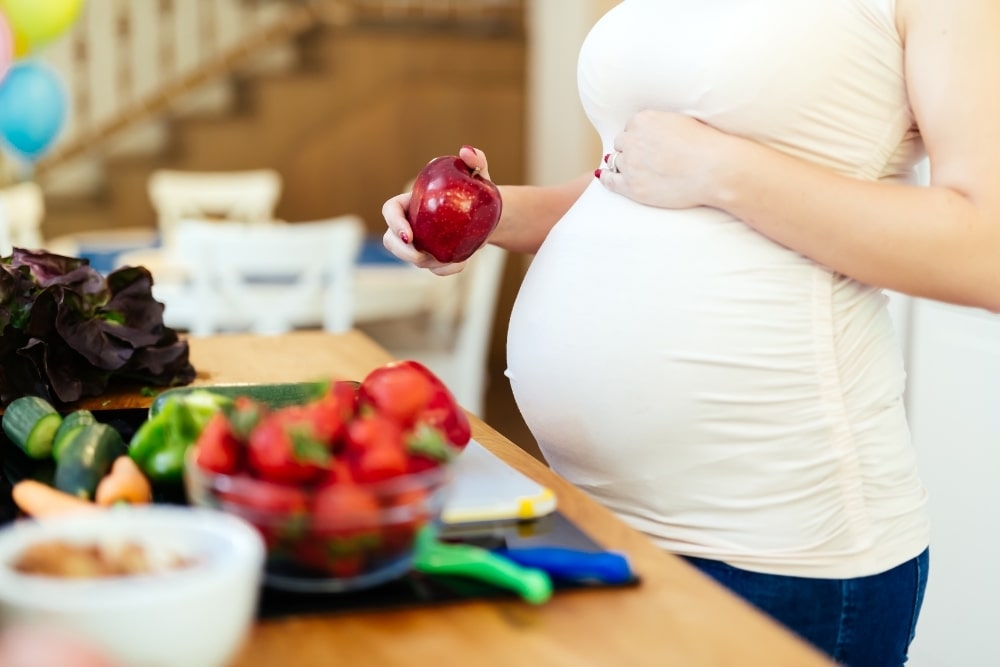You’ve tirelessly sat through the highs and lows of being pregnant, and now the doctor brings up having your baby. Except not on your own time, but through a process called induction.
If your mind is any like my own then I’m sure you had many questions about the process.
Being pregnant with twins myself, I completely understood why my obstetrician asked me to agree to be induced. But, since these were my first babies I didn’t understand much about the birthing process or what it meant to be induced.
Would it hurt more than the body’s natural process through labor, could I have anyone in the room with me, and the biggest question of all – could I eat whatever I wanted during labor if I was induced?
It’s a common question for women about to go through this process – what to eat before being induced. Eat something light and use the restroom. There can be more to it but for the majority of women being induced, this works the best.
Through all my nervous excitement I managed to ask just what I needed to and the rest was answered by the paperwork my doctor handed me.
What Does It Mean To Be Induced and What Is The Process of An Induction?
There are multiple ways to bring a baby into this world, safely in the arms of their mothers. And whichever way a female has to give birth to her baby – the most important thing is that mother and baby remain safe through the entire process.
Labor and delivery can be a long exhaustive journey, regardless of what you’re heading to.
It’s an emotionally intense time for the family and an emotionally exciting time as well. If a woman is going to give birth through induction, it means that her labor will be started with western medicine.
This means Pitocin will be used to activate contractions, allowing the body to begin labor through false pretenses.
It’s no doubt it will be real labor if it works, but the chemical that the mother’s body releases at the start of natural labor, called Oxytocin will be replaced with Pitocin.
How Does Oxytocin Work In the Pregnant Female Body?
There really are just two main things that oxytocin is used in order to have a baby: contractions and to make milk.
Without the hormone oxytocin, or something similar to it in the case of Pitocin the body would not contract to push the baby down and outward.
View in gallery
How similar to oxytocin is the Pitocin?
They both work to speed up, start, or strengthen contractions during child labor.
The only difference between the two is that oxytocin is the body’s natural hormone that is continually produced throughout labor and delivery while Pitocin is a man-made drug version of this hormone.
It’s truly incredible how there can be a synthetic drug to support labor and delivery when it’s needed such as this. In many cases, this is super helpful and necessary to safely deliver a baby.
Should I Expect The Same Process of Natural Labor For Delivering My Baby If I’m Induced?
There are many things in the preparation phase that will be different for you and the baby if you’re being induced, but how about the actual process of labor?
Will labor be exactly the same if you’re induced with Pitocin or should you expect that to be quite a bit different?
With Pitocin, you feel the pain right away there is no warm-up to the intensity of contractions
The many ingredients here are the difference in contractions. they simply aren’t the same if you’re induced with Pitocin as they would be with normal labor.
With oxytocin, the body encourages labor over a generally slow process, a woman could be in the first phase of labor for hours.
The first phase of labor is generally not as painful as the body is just beginning to activate contractions and recognize that it’s time to have the baby soon.
With Pitocin, the body is thrown into the intensity of contractions rapidly, you get the pain factor right off the bat.
Labor will generally start quickly after being administered Pitocin, your body doesn’t get time to adjust to the process of contractions as in natural labor.
The contractions would become closer together, stronger, and occur for longer periods of time with each contraction.
As a result of this you might want pain medicine sooner
Many women make it through natural labor without any pain medication, especially with a homebirth. Except, when a woman is induced those plans might be harder to successfully tackle.
View in gallery
Don’t get me wrong. It is possible to hold off until the pain meds until the baby is born with induced labor, but the brain and the pain have no time to work together.
So your body’s natural pain relief isn’t correlated the same as it would be if your body was naturally creating oxytocin – don’t feel bad asking for pain relief even if you planned not to.
You won’t be able to move around the same as you would in a natural labor
In natural labor, you’re able to move around freely. Nothing is hooked up to your body. When induced, they need to administer the Pitocin in some way or the other, and it’s done through an IV in the arm.
Having an IV hooked up to your arm means that showering will be off-limits, and so will the birthing tub if you planned on using either of those for pain relief.
There is plenty of other ways to soothe your pain during labor and delivery, so don’t fret. You can plan for ways that work around the drip IV you’ll be hooked up to – back rubs are incredible during labor.
The Best Foods to Eat Before Being Induction
If there’s one thing that the end of labor brings is one of the biggest appetites you’ve ever experienced. It seems that with your stomach getting squished by the baby. You have to eat twice as many meals too.
Can I eat at all before being induced?
The truth is, that eating before being induced could become an issue if you have to eventually have an emergency c-section. The other reason that eating the morning of induction is advised against is due to the possibility of pooping during labor.
Aside from those two reasons, you will be asked not to eat during labor because nausea and vomiting are very possible while in the early, and sometimes late stages of labor.
I know it seems like your body is doing all this hard work, and you should be able to eat whatever you’d like to help the labor along. But that isn’t the case with induction or having a baby in the hospital period.
Your body knows exactly what to do, and through your belly might growl the progress of your labor won’t be hindered because you don’t eat that day.
While plenty of fluids are encouraged during labor, solid foods are a no-go the morning of your induction.
View in gallery
What should I eat before the day prior to being induced?
Now the day before being induced is a completely different story – you can eat anything you’d like. Except you might still want to be pickier than usual that day.
As mentioned before labor, delivery, and breastfeeding afterward are a big task for one body to undergo.
Women are designed to go through the strife of having a baby, but it’s your job to set yourself up for success. Think foods that will give you sustained energy, strength, and clarity while having your baby.
High-risk inductions are different than low-risk inductions
Inductions are a common way for women to give birth in today’s world, yet the reasons behind each induction are different.
Some women are advised to be induced because their bodies cannot physically hold their babies much longer(symphysis pubis) which is considered a high-risk induction.
While other women in perfect physical condition choose to be induced to have their babies at the 38 to 40-week mark instead of waiting longer, a low-risk induction.
Food That Is Best For a Low-risk Induction
When I was just in labor with my 5th child, I was sent to the hospital for possible further induction.
I had already eaten just prior to getting there, and even though I didn’t have to actually be induced with Pitocin, it was not an issue that I had just eaten.
My labor was stalled and thankfully picked back up after going back home. My situation would have been considered a low-risk induction.
While there are plenty of other reasons that low-risk inductions occur, you can usually eat whatever you want prior to having one.
Fruit can cause you to go to the bathroom more than usual be aware
Keep in mind that eating lots of fruit before going in for your induction could cause you to go to the bathroom in excess.
Pooping a lot before pushing out your baby isn’t something that you would enjoy while in labor or pushing your baby out while going to the bathroom.
View in gallery
Oftentimes low-risk inductions start when the women are not yet dilated, meaning the cervix is closed and still long. This results in active labor taking days to happen. If this is the case, eating in this waiting period is important.
Nausea during labor happens to plenty of women
Feeling nauseous in the transition time-frame of labor is not uncommon.
The transition phase is the time a woman goes from 7 to 10 centimeters, this is the shortest phase of dilating. It’s also the most intense part of dilation, and this what brings on nausea.
It’s not uncommon for women to feel nauseous during the earlier stages of labor as well. The best things to eat during labor are dry salty foods like crackers and such. Especially if you already know that you’ve been nauseous throughout your pregnancy.
Beans, bread, and carbs are a great pre-induction food
I had this idea in mind (from being a triathlete) that if I carb-loaded prior to labor, then I would have sustained energy throughout the entire process. I was spot on, during the last week of being pregnant I loaded up on protein and carbs.
[amalinkspro type=”showcase” asin=”B000EZYFRA” apilink=”https://www.amazon.com/dp/B000EZYFRA?tag=mominformedcom-20&linkCode=osi&th=1&psc=1″ new-window=”true” addtocart=”false” nofollow=”true” sc-id=”4″ imgs=”LargeImage” link-imgs=”false” specs=”Heinz Baked in Tomato sauce 415g~~~Sold in a pack of 6 cans~~~Gluten Free” btn-color=”#ff9900″ btn-text=”Buy on Amazon” alignment=”aligncenter” hide-prime=”0″ hide-image=”0″ hide-price=”0″ hide-button=”0″ width=”750″]Heinz Beans[/amalinkspro]
I started labor off feeling great, then my labor lasted 3 days and I had good energy throughout the entire process. I even had beans from the crockpot right after giving birth to start my breastfeeding journey off well.
Gestational diabetes can change what you’re able to eat prior to being induced
If you have been diagnosed with gestational diabetes then it’s important to speak with your practitioner before approaching your induction date. Be sure to ask if you should take your medication prior to being induced, it’s necessary at times.
The Best Foods For a Moderate-risk Induction
If you’re having to be induced because your baby’s growth is altered or halted for any reason – you will be considered to have a moderate risk induction.
Pre-eclampsia is another common reason for moderate-risk inductions, due to high blood pressure.
When having a moderate-risk induction you will be able to eat foods that are light but potent. Think bone broths, as well as chicken broth.
View in gallery
Soups are great for moderate risk inductions and are packed with nutrients to assist your body in labor and delivery.
With this type of induction your delivery could still end up with having an unexpected c-section, but the ultimate plan is for your labor to progress as expected so that you can have a vaginal delivery.
You’ll need to be prepared for the possibility of having a c-section, which women are advised to not eat at all prior to having a c-section.
Jello, broths, and gelatin are all great options for moderate risk inductions.
Can I Eat Before A High-risk Induction?
In the case of a high-risk induction, you will not be advised to eat anything before coming into the hospital. Women have high-risk inductions for many reasons, but especially if the baby is showing signs of fetal distress.
Ladies who are having a high-risk induction are also at the possibility of having a ceasarian.
In addition, when your doctor is planning to flip your baby head down immediately prior to inducing you, then you need to not eat any time after midnight prior to coming into the hospital for your induction the next morning.
If your baby is showing significant signs of fetal distress, resulting in you being rushed into a c-section. It is best to have an empty stomach.
10 foods That Offer the Most Energy To Get Through Labor and Delivery
Really the week prior to having your baby should be focused on having a well-balanced diet. Eating plenty of green leafy vegetables, fruits, and protein-rich foods are wonderful for the last few weeks of pregnancy.
Starting your breastfeeding journey off on the right foot is super important as well, which is dependent on eating enough calories and nutrient-dense foods.
Try to eat these types of foods the week prior to being induced, the day prior to induction, and during labor.
View in gallery
Keep The Foods You Eat at The Start of Labor Simple
If you’ve already felt that first contraction, you’ll want to keep the foods you eat fairly simple – no fried or greasy foods. They will probably end up upsetting your stomach more than anything.
Peanut butter will be your best friend
Peanut butter can go on anything really, from toast to bananas to the smoothie. You should try and get some peanut butter in your meal anytime you can during labor, it’s a superfood you won’t regret filling upon.
Peanut butter and bananas are a great way that’s gentle on the stomach and can provide a big boost of energy that sticks with you for longer than other foods would.
[amalinkspro type=”showcase” asin=”B00061ETX2″ apilink=”https://www.amazon.com/dp/B00061ETX2?tag=mominformedcom-20&linkCode=osi&th=1&psc=1″ new-window=”true” addtocart=”false” nofollow=”true” sc-id=”4″ imgs=”LargeImage” link-imgs=”false” specs=”AMERICA’S FAVORITE* – From a brand that has been trusted for generations, Jif creamy peanut butter is made with simple ingredients and has the fresh roasted peanut butter taste America loves. One bite of our Jif spread and you’ll be reminded of your very best childhood memories.~~~SPREAD THE LOVE – It’s easy to do with our twin pack of smooth peanut butter! It is smooth textured and easy to spread with no stirring required, so you can make sandwiches, have a snack or bake delicious cookies quickly and easily.” btn-color=”#ff9900″ btn-text=”Buy on Amazon” alignment=”aligncenter” hide-prime=”0″ hide-image=”0″ hide-price=”0″ hide-button=”0″ width=”750″]Jif Creamy Peanut Butter[/amalinkspro]
Oatmeal is filled with carbs and protein
Get a big bag of oatmeal from the bulk section at your store the week prior to your induction. Have it sit in the fridge as cold over-night oats or make a pan while you’re in labor or the day period to your induction.
Oatmeal is loaded with healthy carbs, and you really can’t go wrong with all the toppings of your choice. Make sure to load it up with peanut or almond butter to pack in the protein as well.
Sweet potatoes are filled with energizing nutrients
Sweet potatoes are filled with beneficial carbohydrates, just one cup equates to 180 calories. This means that you don’t have to fill your stomach much to get in the much-needed calories it takes to have a baby.
Did you say I can load up on pasta?
The main focus here is going to be carbohydrates, just think of giving birth like a marathon. If you were going to run a race, you would want to carb to load to have that substance readily available for your body to use while running.
It’s the same thing when giving birth, your body needs to utilize sources of carbohydrates that are readily available in an abundance.
View in gallery
Can Certain Foods Help Progress or Induce Labor Themselves?
Certain foods can help your labor progress forward more than other foods. The foods listed below are super helpful to women in labor.
Try and have them on hand once you hit 38-weeks pregnant because it can happen at any time from then onward.
Spicy food can stimulate contractions
To date, there has only been one study that proves the connection between spicy foods and the stimulation of contractions in pregnant women.
The theory behind it is that much like castor oil, spicy foods stimulate the uterus to contract – especially if you’re already in labor.
This can help a lot for women who are already 40 weeks pregnant or have already entered into labor. During the stalls of labor(if they occur) you could dash a bit of Cayenne on some sweet potato for a great revamp of contractions.
Be careful not to eat fried and spicy food that will probably cause heartburn. If there is one thing you don’t want in labor, it would be heartburn.
Pineapple is great for inducing labor because of a special enzyme in it
Like most of the foods presented on this list, the notion behind them inducing labor is not completely supported by peer-reviewed studies – but they’re worth loading up on at the end of pregnancy.
Pineapple has an enzyme in it called bromelain, this enzyme should assist in softening the cervix. The goal to have real contractions that result in giving birth is that your cervix must be softened.
A soft-ripe cervix is one that will dilate, and move in the right direction during labor. Even though there are few studies behind the actual process of bromelain stimulating contractions.
There have been studies where pineapple juice extract is direct to uterus muscles, resulting in muscle contracting. Now go drink loads of pineapple juice to ripen your cervix and stimulate your contractions.
View in gallery
Dates are a superfood and help women who are at full term
If you want the benefits that date have to offer at the end of your pregnancy, be sure to eat 6 dates a day. Six dates a day keeps the doctor away?
Maybe, a study done on pregnant women who ate 6 dates a day for the final month of their pregnancy were able to go into labor on their own, plus were more dilated than those who did not eat any dates.
Your cervix and uterus love fiber to keep contractions moving along, so if you eat dates the day prior to having your baby. Then you will have a better chance of keeping contractions strong throughout labor and delivery.
Aside from that, dates offer a ton of energy the kind that you want while giving birth to a baby.
I had a bag of dates from Costco sitting in the fridge that I would grab from when I got hungry. I would also throw a bit of peanut butter on them during labor.
Eggplant is great for stimulating contractions and assisting with labor
There is a famous dish called “The eggplant baby dish” at a restaurant in Atlanta Georgia. It’s been known to induce women’s labor within two days of consuming the delicious dish.
While there aren’t any studies done on eggplant actually inducing labor, there is enough real-life experience with this recipe and labor coming directly after – the more credit to it!
The recipe can be found online at Scalini’s website, look on Google for the famous restaurant’s website, and look for the ‘eggplant babies’ or the ‘eggplant parmesan dish’.
It can’t hurt to get more vegetables during the last month of pregnancy if you don’t go right into labor.
View in gallery
In Conclusion
The truth is that every induction is different, and you will need to know the specifics of your induction.
Whether you are having a low-risk, moderate risk or high-risk induction is one of the most important factors in having a successful experience with the food preparation you take before your procedure.
The last thing that you want is to have heartburn, an upset stomach, or worse during labor, delivery, or an emergency c-section. You should always ask your obstetrician what you can or cannot eat the morning of your induction, or the day prior.
In regards to the last month of pregnancy – make sure that you are getting in plenty of fruits, veggies, grains, and proteins to accumulate a well-balanced diet well before you have to give birth.
A strong body during labor and delivery is what every woman needs, especially in the case that the mother has to have an emergency c-section and need even greater strength to heal in the coming weeks after your baby is born.
Do your best, and do what is manageable for you and your life – your happiness creates the best success for labor and delivery after an induction.
Sources
What To Eat Before Induction: Everything You Should Know – My Parenting Journey
Can You Eat Before Labor Induction? – Live Strong
9 Things Every New Mom Should Do Before Getting Induced – Romper






